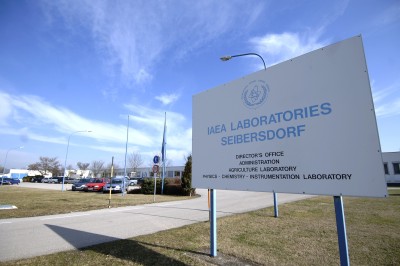What are the Seibersdorf Laboratories?
Nuclear technologies and applications should be safely researched under international supervision. In Seibersdorf, Austria, the International Atomic Energy Agency maintains eight nuclear applications laboratories. Read on to find out more about the Seibersdorf Laboratories!
 Since 1962, the IAEA is operating laboratories in Seibersdorf, Austria. / Picture: © IAEA International Atomic Energy Agency / Dean Calma (CC BY-SA 2.0)
Since 1962, the IAEA is operating laboratories in Seibersdorf, Austria. / Picture: © IAEA International Atomic Energy Agency / Dean Calma (CC BY-SA 2.0)
Especially in times of climate crisis, it is of utmost importance to explore old and new energy sources and to find alternatives and possibilities to produce energy as environmentally friendly as possible. In the case of nuclear science and nuclear technologies, the applications are much broader than just energy production.
The Seibersdorf Center is operated by Seibersdorf Labor GmbH, which was installed in 2008. The owners are, via AIT, the Republic of Austria (50.46%), which is subordinate to the Federal Ministry for Climate Protection, Environment, Energy, Mobility, Innovation and Technology, and the Federation of Austrian Industries.
The International Atomic Energy Agency (IAEA) has also operated laboratories in Seibersdorf since 1962. The Department of Nuclear Sciences and Applications of the IAEA also runs laboratories here - and in Vienna - which have since become international reference centers.
Located at Seibersdorf are the FAO/IAEA Agriculture and Biotechnology Laboratory (together with the Food and Agriculture Organization FAO, for soil science, plant and animal breeding, entomology and agrochemicals), the Physics, Chemistry and Instrumentation Laboratory (chemistry and instrumentation, dosimetry, isotope hydrology), and the Safeguards Analytical Laboratory (isotope analysis, chemical analysis, clean laboratory for detection), as well as a training center where more than 2300 scientists and technicians from 120 countries have been trained over the past decades. The IAEA laboratories are operated by the General Services and Safety Section (GESS). The IAEA's Safeguards Analytical Laboratory gained worldwide notoriety, particularly in 2007, when evidence of an Iranian nuclear program was found there.
As well as providing technical and analytical services, the laboratories support and implement activities to meet the developmental needs of Member States in a variety of subject areas. They also conduct applied research and development, provide training to Member States, and deliver capacity-building.
History of the Seibersdorf Reactor Center
In 1958, the Austrian Study Association for Atomic Energy (SGAE), founded two years earlier for Austria's entry into the nuclear age, purchased a 110-hectare site in the municipality of Seibersdorf for a research location.
The Seibersdorf Reactor Center was built on this site between 1958 and 1960. In addition to institutes for electronics, physics, chemistry, metallurgy and radiation protection, the first research reactor in Austria, the Adapted Pool-Type Reactor Austria, was built as a central research facility. An interim storage facility for low-level radioactive waste was also built. Since 1962, the IAEA has also operated laboratories in Seibersdorf.
Since nuclear energy did not develop into the leading technology in Austria, as had been assumed in the 1950s, research was also diversified at the reactor center. After Austria's nuclear phase-out, the original task became obsolete, and only the research reactor continued to operate. This move away from concentrating on nuclear energy was also reflected in the change of name to the Seibersdorf Research Center. The nuclear reactor was shut down in 1999-2004.
IAEA's ReNuAL and ReNuAL2 Initiative
However, since the plant has again been the focus of research for several years, modernization and enlargement of the plant are urgently needed.
Yet, over 50 years after they were inaugurated, the laboratories haven't received a comprehensive renovation or equipment upgrade. It is for this reason that the IAEA has established the Renovation of the Nuclear Applications Laboratories project (ReNuAL), which aims to begin modernizing nuclear application laboratories.
A new Insect Pest Control Laboratory, a new medical linear accelerator facility for the IAEA's Dosimetry Lab, and the Amano Laboratories building was completed in 2014 as part of the Renovation of the Nuclear Applications Laboratories (ReNuAL). In 2020, the Amano Laboratories building was named in honor of the late Director General Yukiya Amano, and it will house the animal production and health (APHL), soil and water management and crop nutrition (SWMCNL), and food safety and control (FSCL) laboratories.
In October this year, the process of modernization was developed further and on this occasion, IAEA Director General Rafael Mariano Grossi acknowledged “After two years of hard preparation, we now begin construction to complete the modernization of our invaluable Seibersdorf labs — laboratories that make important contributions in the global fights against disease, climate change and world hunger.”
Currently, Phase ReNuAL2 is in the progress of the renovation initiative and a new building will house three new laboratories. Plant Breeding and Genetics (PBGL), Terrestrial Environment and Radiochemistry (TERC), and Nuclear Science and Instrumentation (NSIL). These laboratories will assist countries in addressing challenges related to climate change, food security, environmental management, etc. The new building is expected to be completed by the end of 2024.
As part of ReNuAL2, the IAEA will also construct new greenhouses - necessary for programs such as plant breeding, food safety, soil and water management, and crop nutrition - adjacent to the new laboratories. This last element of ReNuAL2 will now be the focus of resource mobilization efforts.
Seibersdorf's nuclear applications laboratories celebrate their 60th anniversary this year. ReNuAL2 is the latest milestone in a decade-long effort to modernize the facility.



